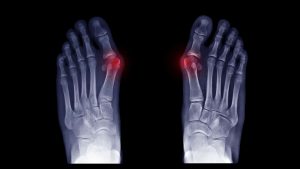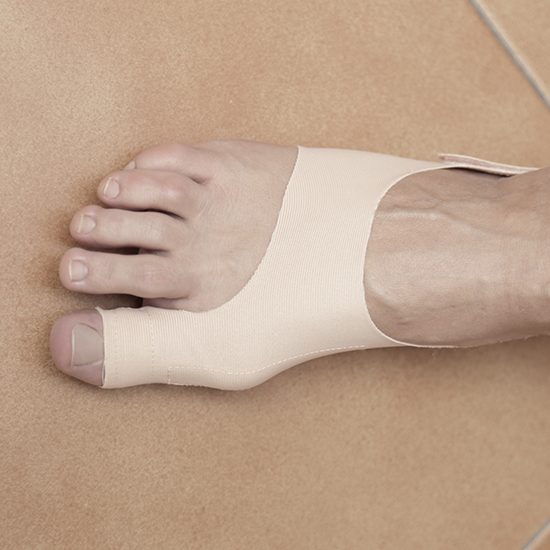A bunion is not just an ordinary, unsightly bump that will go away on its own and find another foot to place itself upon.
This condition can damage the toe, joints, and foot, affecting overall function. For most people, bunions are harmless and the use of over-the-counter bunion pads can prevent them from getting worse.
The Latin name for bunion is hallux valgus. Hallas translates into big toe and valgus to turned away from the midline of the body.
If left untreated, bunions can affect the ability to walk, stand for long periods and in some instances, can cause permanent physical deformities of both the toe and foot.

Bunions are the bane of more than half of all American women, and are twice as common among people over sixty years of age.
According to our teams at JAWS Podiatry, bunions are 10 times more likely to develop in women than men.
The reason for this concerns high heeled shoes, which tip the weight of the body forward, forcing the toes into the narrow front part of the shoes.
They may not cause any discomfort at first, but they can become very painful over the course of time.
Bunionettes, which are also known as tailor’s bunions, are painful, bony profusions that are usually found at the base of the baby toe rather than under the big toe, as is the case with bunions.
According to Harvard Health, the moniker, tailors bunions, refers to the fact that tailors at one time sat with their legs crossed all day long, which caused the outer side of their feet to rub on the ground.
Bunionettes are known to occur as the result of constant pressure upon the side of the foot near the pinky toe.
There are a variety of treatment options that can be performed with or without surgery.
It would be difficult to not notice a bulging bump on the outside of the base of your big toe, which is almost always a bunion.
Swelling, redness or soreness is often prominent in the area surrounding the big toe joint, although they may not require surgical intervention (lapiplasty), you should consider seeing the specialists if you have: continuous pain in your big toe; a bump on your big toe joint; difficulty finding shoes that fit properly or a decreased mobility of either your big toe or foot.
Both bunions and bunionettes can result from arthritis, heredity affecting foot structure or anatomy or misalignment of the foot.
People afflicted with Rheumatoid arthritis may also have higher tendency to develop bunions. Their most common cause, however, are high heels that squeeze the toes and force them to fold over one another.
Another risk factor is poorly fitting shoes other than high heels that don’t fit properly, may be too tight, too narrow or too pointed.
Shoes should always conform to the shape of the foot without squeezing, pushing or passing any part of it. There are some occupations that make people more vulnerable to both bunions and bunionettes than others.
For example, those involved in jobs that require a great deal of standing and walking, such as teaching, nursing and ballet dancers whose feet are forced to endure repetitive stress are very susceptible to the formation of bunions and bunionettes.
A bunionette occurs when constant pressure is applied to the side of the foot. Where shoes rub against the area of the bunionette, there is a significant risk that this can cause blisters, which can turn into an ulcer.
This can mushroom into a very dangerous situation for diabetics if not addressed immediately by a professional podiatrist.
Once evaluated and other causes are eliminated, an initial plan can be introduced.
Conservative treatments and lifestyle changes, like wearing footwear with a wider box area, This can help prevent rubbing against the bunion or bunionette and offer some relief from pain.
Throw out those shoes that are too tight and forget about those high heels, which sorry to say, should also find some dark place by to die by the wayside. Pain can be addressed by cushioning the area with padding such as: felt, moleskin or a donut-shaped pad.
When the bunion is irritated and painful,.warm soaks, ice packs and anti inflammatory drugs such as aspirin or ibuprofen can help.
Shoe stretchers can relieve pressure on the foot and inserts are helpful when it comes to redistributing weight, which will prevent the bunion from constantly rubbing against the shoe.
Surgical Considerations
Bunions usually do not require surgery, but if home remedies fail and the pain becomes debilitating and is impervious to conservative treatment, it’s time to call our teams at JAWS Podiatry for a proper evaluation for our minimally-invasive approach to bunion surgery.
There are important things to understand before hand in order for things to go as smoothly as possibly.
For one thing, surgery may not eliminate all of the symptoms and for another, even the simplest procedure will require staying off your feet for a minimum of six weeks (and longer with more complicated surgeries).
Be prepared that it may take up to a full year to recover, depending on the procedure. Talk to other patients who have had the operation performed and weigh their comments before making a final decision.
Surgical Options
We offer many surgical alternatives and the purpose of all of them is to relieve pain and restore normal function by eradicating the bunion and readjusting the joint, tendons, ligaments and nerves. X-rays and measurements are the first steps taken, as they permit the classification of the bunion as mild, moderate or severe.
Other factors that influence surgical considerations include” age; activity level; general health; bone and connective tissue strength.
Several approaches are available, depending on the severity of the condition.It stands to reason that the more severe the condition, the more complicated and risky the surgery.
For mild bunions, a bunionectomy is recommended. This involves shaving off the enlarged section of the bone and readjusting the muscles, tendon and ligaments surrounding the joint.
Recovery usually takes between 3 and 4 weeks and requires wearing a post-operative shoe. It must be said that this procedure does not always correct the deformity that caused the bunion to develop.
In the case of moderate bunions, the surgeon may need to cut the bone close to the metatarsal head and shift it back into place.
This is known as osteotomy. Screws and pins hold the bone in place and may require 4 to 6 weeks recovery time in addition to the need to wear a short cast and use crutches.
Severe cases fare better with a procedure which requires a cut farther down the metatarsal bone, in which bones are kept in place by screws, pins or plates. If the joint cannot be repaired, it will be replaced with an artificial one.
Recovery time is hefty and known to take anywhere from 6 to 12 weeks Special casts or shoes will permit the patient to walk on his or her heel while recovering.
Bunionette surgery is similar, but a bit less complicated than the procedure employed for milder cases of bunions. It usually requires a small incision above the bony lump, which is cut away and fixed into position with just one screw.
Possible Complications And Outcomes
There can be not foretelling if complications will occur. Several studies affirm that 85-90% of patents are satisfied with the results of bunion snd bunionette surgery.
Truth be told, expectations should be geared to situations being better, but not perfect.
The most common complication is a reoccurrence of the bunion, which according to Harvard Health, occurs in 16% of cases. A complication known as non-union can also occur, which concerns the slow (or lack of) fusion of the cut bone. This may require additional surgery to correct.
All in all, we are here to guide you every step of the way, and while complications can happen, via our team’s expert care, they aren’t like to arise.
If you reside anywhere throughout Florida, the United States or beyond, and you’re in need of any type of bunion or bunionette removal surgery, call our teams at Jaws Podiatry for an in-person or virtual consultation!
We’re always here to help you and your feet!
SCHEDULE APPOINTMENTConservative treatment often includes wearing silicone shields, wide unfashionable shoes and occasionally injections of anti-inflammatory medication. Unfortunately, since this these are fixed structural deformities, conservative care can only go so far and surgery is generally recommended. Most bunions / bunionettes become painful and irritate the foot inside shoes at some point and being proactive at preventing further deterioration is usually the best decision.
